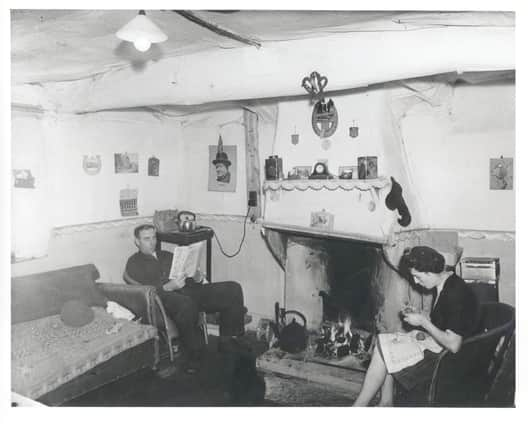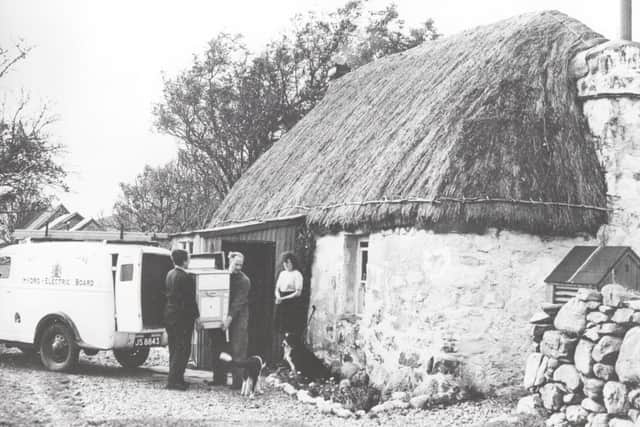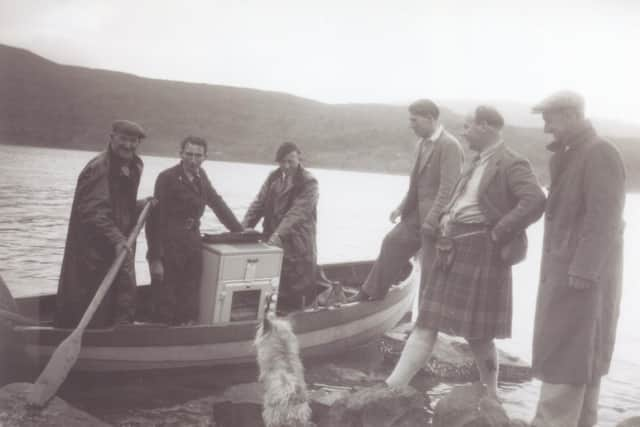When electricity came to the last homes in the Scottish Highlands


Electricity expanded rapidly into the Highlands and Islands from the late 1940s – some 20-odd years after the first large-scale hydro scheme for domestic power was opened on the River Clyde at Lanark.
Comfort, convenience and a boost for business, industry and tourism was how the onset of electricity was promoted.
Advertisement
Hide AdAdvertisement
Hide AdIt was even said the onset of electricity would halt depopulation.


A remarkable set of photographs gifted to the Am Baile archive of Highland society and culture documents the massive shift in way of life, when oil and cruisie lamps gave way to a demand for new white goods and appliances.
Images show delivery men crossing woodland and moor to get these new items of desire into homes, with one picture showing a cooker being dispatched to a home in Lochalsh by rowing boat and another capturing several men moving a new electric oven through a forest.
The photographs were taken by Bill Ramsay for the North of Scotland Hydro Board, which was established by an Act of Parliament in 1943. Catherine MacPhee, trainee archivist at Skye and Lochalsh Archive Centre, said: “It was a life-changing event and it was promoted in terms of economic improvement and social development of the Highlands.
"In one image you see a field where hay is being ploughed and then you also see a huge channel that has been dug out for the cables. There are obviously people who remember when that happened.”


In the early 1940s, Thomas Johnston, Secretary of State for Scotland, had a vision for “large-scale reforms that might mean Scotia Resurgent”. Expanding hydro power was a priority.
In 1944, the Lochalsh Distribution Scheme became the first project of the board, with electricity brought into villages such as Balmacara, Nostie, Dornie and Plockton.
Ms MacPhee said the board embarked on tours of village halls to promote the benefits of electricity – as well as show off the latest in home appliances, which were then sold in hydro board shops.
Advertisement
Hide AdAdvertisement
Hide AdArchive pictures show rows of neatly dressed women in the audience, while kettles, foodmakers and hoovers are on display on the stage. The appliances were also displayed at agricultural shows.
Huge infrastructure projects over the Highlands altered the landscape for all time.
A meeting of the Royal Scottish Geographical Society in March 1950 heard 29 generating stations and 14 new lochs were created as part of the hydro scheme, with 13 lochs enlarged.
A man-made underground river ran into into Loch Lomond for the first time that month.
Loch Sloy, fed by streams whose courses had been changed, was now 30 feet above its natural level.
Thousands of local men, as well as former prisoners of war, worked on the projects.
The first of the North Of Scotland Hydro Board schemes was switched on at the River Morar in December 1948 by Catherine Mackenzie, a local crofter and widow.
A report said: “As Mrs Mackenzie turned a control wheel, the low rumble of the turbines was heard and a blaze of light succeeded the dim illumination of oil lamps in which the ceremony had began.”
Advertisement
Hide AdAdvertisement
Hide AdMs Mackenzie then spoke to the crowd in Gaelic: “Let light and power come to the crofts.”
A message from the Editor:
Thank you for reading this article. We're more reliant on your support than ever as the shift in consumer habits brought about by Coronavirus impacts our advertisers.
If you haven't already, please consider supporting our trusted, fact-checked journalism by taking out a digital subscription.
Comments
Want to join the conversation? Please or to comment on this article.